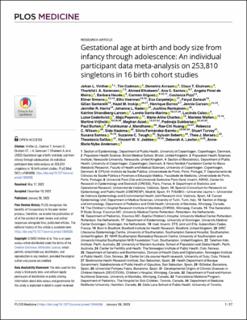Gestational age at birth and body size from infancy through adolescence: An individual participant data meta-analysis on 253,810 singletons in 16 birth cohort studies
| dc.contributor.author | Vinther, Johan L. | |
| dc.contributor.author | Cadman, Tim | |
| dc.contributor.author | Avraam, Demetris | |
| dc.contributor.author | Ekstrøm, Claus T. | |
| dc.contributor.author | Sørensen, Thorkild I. A. | |
| dc.contributor.author | Elhakeem, Ahmed | |
| dc.contributor.author | Santos, Ana C. | |
| dc.contributor.author | Pinot de Moira, Angela | |
| dc.contributor.author | Heude, Barbara | |
| dc.contributor.author | Iñiguez, Carmen | |
| dc.contributor.author | Pizzi, Costanza | |
| dc.contributor.author | Simons, Elinor | |
| dc.contributor.author | Voerman, Ellis | |
| dc.contributor.author | Corpeleijn, Eva | |
| dc.contributor.author | Zariouh, Faryal | |
| dc.contributor.author | Santorelli, Gilian | |
| dc.contributor.author | Inskip, Hazel M. | |
| dc.contributor.author | Barros, Henrique | |
| dc.contributor.author | Carson, Jennie | |
| dc.contributor.author | Harris, Jennifer Ruth | |
| dc.contributor.author | Nader, Johanna L. | |
| dc.contributor.author | Ronkainen, Justiina | |
| dc.contributor.author | Strandberg-Larsen, Katrine | |
| dc.contributor.author | Santa-Marina, Loreto | |
| dc.contributor.author | Calas, Lucinda | |
| dc.contributor.author | Cederkvist, Luise | |
| dc.contributor.author | Popovic, Maja | |
| dc.contributor.author | Charles, Marie-Aline | |
| dc.contributor.author | Welten, Marieke | |
| dc.contributor.author | Vrijheid, Martine | |
| dc.contributor.author | Azad, Meghan | |
| dc.contributor.author | Subbarao, Padmaja | |
| dc.contributor.author | Burton, Paul | |
| dc.contributor.author | Mandhane, Puishkumar J. | |
| dc.contributor.author | Huang, Rae-Chi | |
| dc.contributor.author | Wilson, Rebecca C. | |
| dc.contributor.author | Haakma, Sido | |
| dc.contributor.author | Fernández-Barrés, Sílvia | |
| dc.contributor.author | Turvey, Stuart | |
| dc.contributor.author | Santos, Susana | |
| dc.contributor.author | Tough, Suzanne C. | |
| dc.contributor.author | Sebert, Sylvain | |
| dc.contributor.author | Moraes, Theo J. | |
| dc.contributor.author | Salika, Theodosia | |
| dc.contributor.author | Jaddoe, Vincent W. V. | |
| dc.contributor.author | Lawlor, Deborah A. | |
| dc.contributor.author | Andersen, Anne-Marie Nybo | |
| dc.date.accessioned | 2023-04-24T20:43:11Z | |
| dc.date.available | 2023-04-24T20:43:11Z | |
| dc.date.created | 2023-04-21T09:49:06Z | |
| dc.date.issued | 2023 | |
| dc.identifier.issn | 1549-1277 | |
| dc.identifier.uri | https://hdl.handle.net/11250/3064748 | |
| dc.description.abstract | Background Preterm birth is the leading cause of perinatal morbidity and mortality and is associated with adverse developmental and long-term health outcomes, including several cardiometabolic risk factors and outcomes. However, evidence about the association of preterm birth with later body size derives mainly from studies using birth weight as a proxy of prematurity rather than an actual length of gestation. We investigated the association of gestational age (GA) at birth with body size from infancy through adolescence. Methods and findings We conducted a two-stage individual participant data (IPD) meta-analysis using data from 253,810 mother–child dyads from 16 general population-based cohort studies in Europe (Denmark, Finland, France, Italy, Norway, Portugal, Spain, the Netherlands, United Kingdom), North America (Canada), and Australasia (Australia) to estimate the association of GA with body mass index (BMI) and overweight (including obesity) adjusted for the following maternal characteristics as potential confounders: education, height, prepregnancy BMI, ethnic background, parity, smoking during pregnancy, age at child’s birth, gestational diabetes and hypertension, and preeclampsia. Pregnancy and birth cohort studies from the LifeCycle and the EUCAN-Connect projects were invited and were eligible for inclusion if they had information on GA and minimum one measurement of BMI between infancy and adolescence. Using a federated analytical tool (DataSHIELD), we fitted linear and logistic regression models in each cohort separately with a complete-case approach and combined the regression estimates and standard errors through random-effects study-level meta-analysis providing an overall effect estimate at early infancy (>0.0 to 0.5 years), late infancy (>0.5 to 2.0 years), early childhood (>2.0 to 5.0 years), mid-childhood (>5.0 to 9.0 years), late childhood (>9.0 to 14.0 years), and adolescence (>14.0 to 19.0 years). GA was positively associated with BMI in the first decade of life, with the greatest increase in mean BMI z-score during early infancy (0.02, 95% confidence interval (CI): 0.00; 0.05, p | |
| dc.description.abstract | Gestational age at birth and body size from infancy through adolescence: An individual participant data meta-analysis on 253,810 singletons in 16 birth cohort studies | |
| dc.language.iso | eng | |
| dc.title | Gestational age at birth and body size from infancy through adolescence: An individual participant data meta-analysis on 253,810 singletons in 16 birth cohort studies | |
| dc.title.alternative | Gestational age at birth and body size from infancy through adolescence: An individual participant data meta-analysis on 253,810 singletons in 16 birth cohort studies | |
| dc.type | Peer reviewed | |
| dc.type | Journal article | |
| dc.description.version | publishedVersion | |
| dc.source.volume | 20 | |
| dc.source.journal | PLoS Medicine | |
| dc.source.issue | 1 | |
| dc.identifier.doi | 10.1371/journal.pmed.1004036 | |
| dc.identifier.cristin | 2142402 | |
| dc.relation.project | EC/H2020/733206 | |
| cristin.ispublished | true | |
| cristin.fulltext | original | |
| cristin.qualitycode | 2 |
Tilhørende fil(er)
Denne innførselen finnes i følgende samling(er)
-
Artikler [5061]
-
Publikasjoner fra CRIStin FHI [7531]
